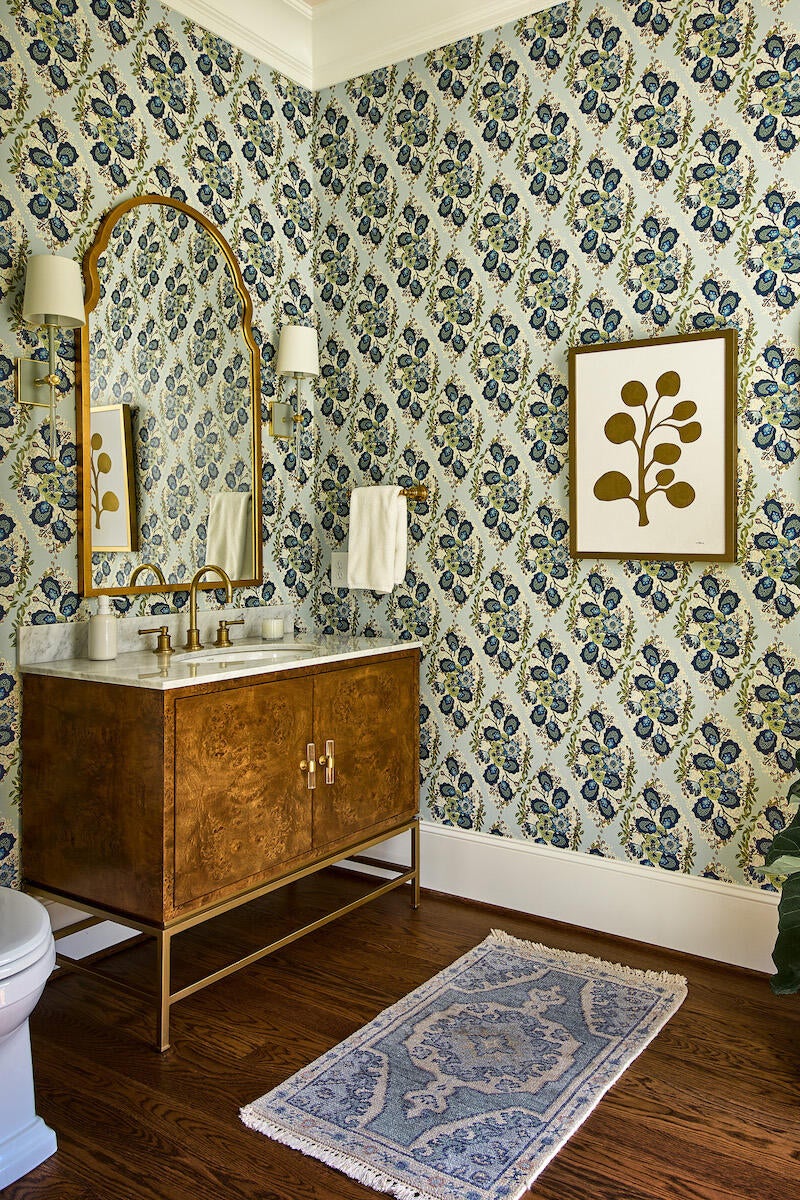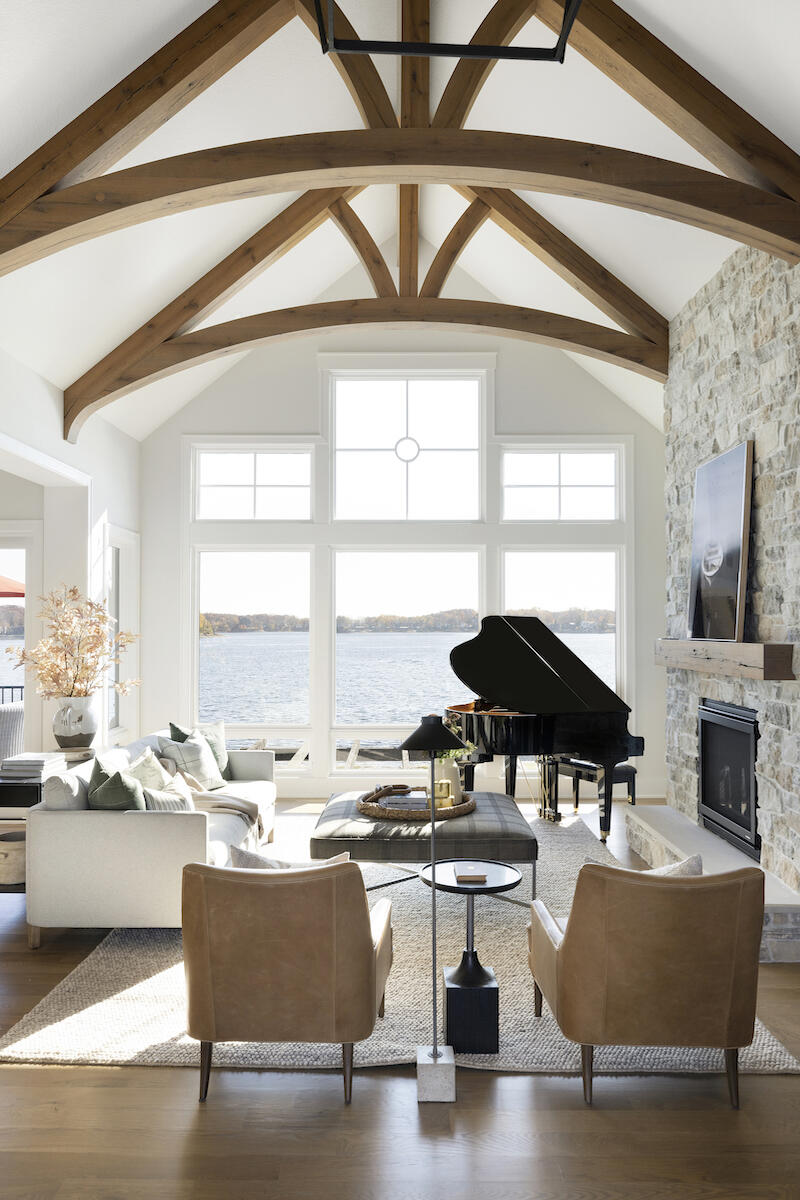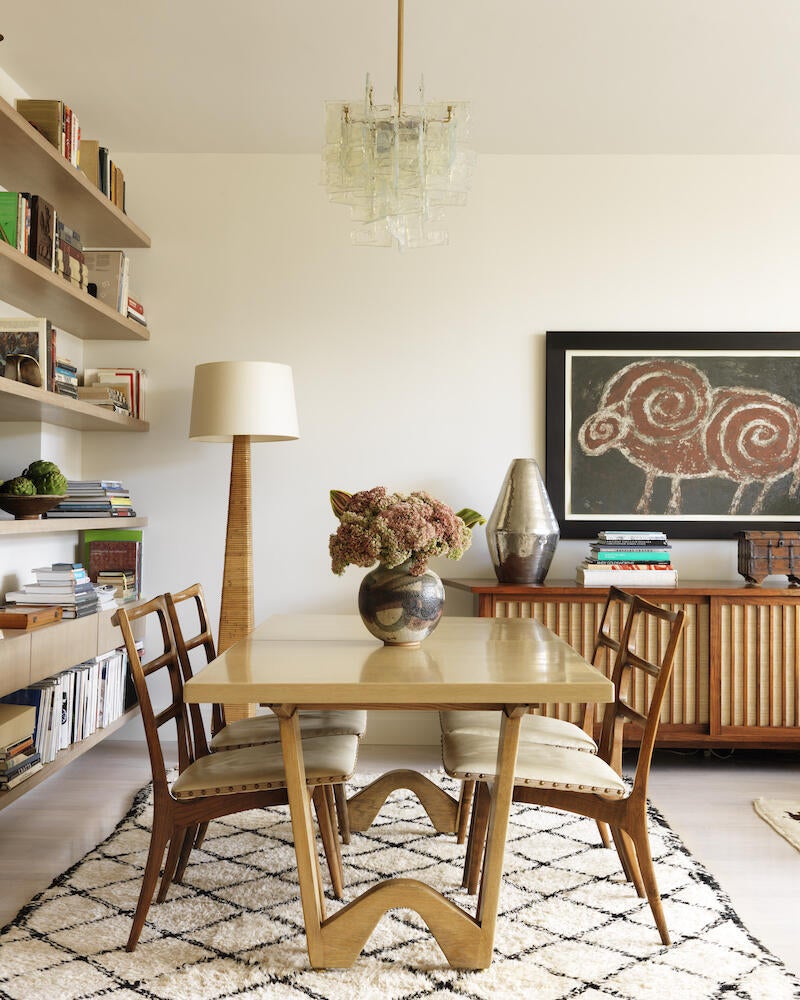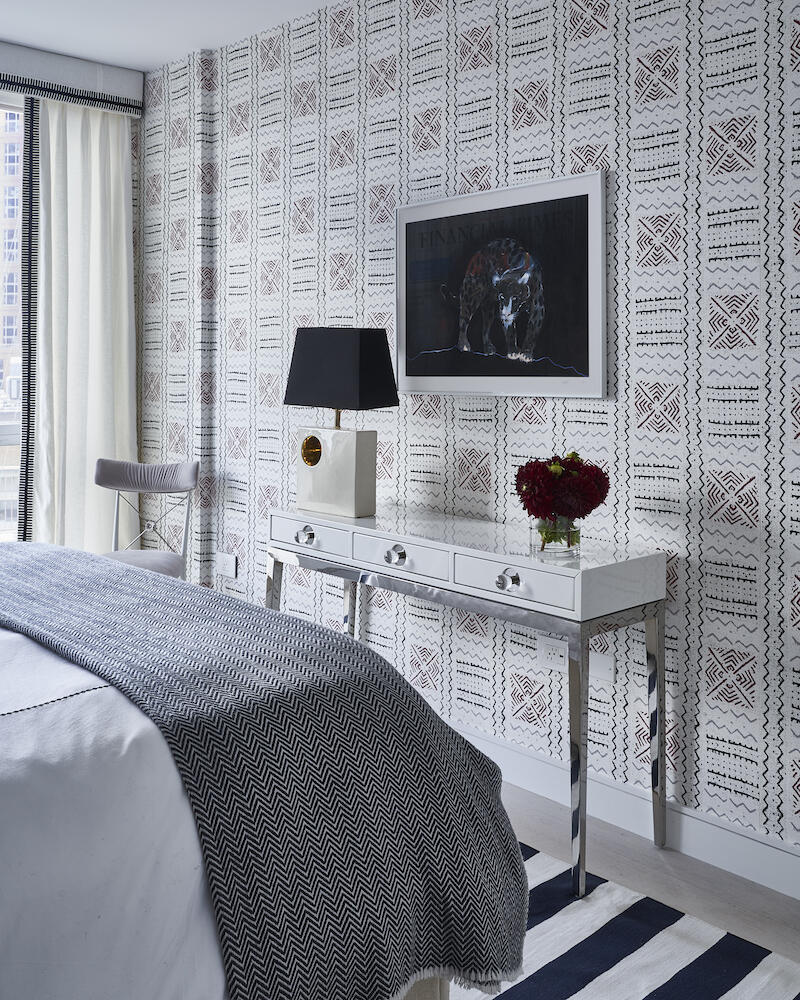You’ve spent eons tracking a project’s every detail. Then, all at once, those decisions come together just so. What separates a good installation from a bad one? We asked seven designers to share their secrets.
After months or even years of planning, being able to stand in the completed room you designed is widely regarded as one of the most rewarding moments of a project. But to get there, designers and their teams must clear one final hurdle: the installation. A smooth install day requires extensive coordinating in order to avoid chaos when a houseful of furniture and a team of subcontractors all arrive on-site. Without spending quality time on the logistics, pieces could be missing, damages could rack up and the final result could be a far cry from that gorgeous rendering you’ve been working toward bringing to life. But by diving into the details, a stress-free (or at least relatively seamless) install day can soon be yours.
Prep Talk
Getting ready for installation takes immense foresight. There are so many moving parts, all descending upon a house at the same time, with everyone working around each other to accomplish the same task: making a beautiful, livable house. All those parts and people don’t just come together overnight. Dallas-based Traci Connell’s team starts planning a minimum of a month in advance. “I like to be looking at an installation date at least four weeks out because there are so many people to coordinate with,” she says. “There’s an art installer, the delivery and moving team, and sometimes an electrician or drapery installer, all in addition to my design team—and then it obviously has to work for the client. It’s definitely something that can take a few rounds in order to get everybody to agree on one particular date.”
For some projects, a single day might be sufficient; others require multiple days, depending on the scale and scope of the job. Sara Bengur, a designer based in New York, says that her most turnkey projects—in which her team will essentially move a client in, unpacking their clothes and stocking the fridge in addition to adding all the sconces with bulbs and hanging the art—take at least a week to complete. “We set aside two days at the end of an installation where it’s just going to be my design team and a cleaning crew,” says Bengur. The logistical acrobatics that go into getting to those final days right can be quite a feat. “One of my clients who is an actor compared it to a fim production,” she says. “We have to be super organized and make sure that we’ve got our schedule set each day so we know who’s coming when and what’s going to be accomplished while they’re there.”
While some designers, particularly those who use receivers or warehouses, opt for an en masse install, not all do. Some favor finishing a project in phases—having lighting installed one day, then drapery a few weeks later and furniture after that. “I’ve always been fascinated by how some designers will house pieces at a central receiver, wait for everything to arrive, and then, boom, it all gets installed—I find that hard unless it’s a complete renovation or new build,” says Los Angeles–based Peti Lau. “Pieces tend to trickle in, and particularly when you have clients actively living in a home, doing it in batches always makes the most sense to me. Especially if I have a client in New York, I’ll install what I can when I’m in town and then block out days to come back once more of the pieces have arrived.”
Supply chain delays during the pandemic upended many designers’ long-seated resistance to partial installs, forcing them to make concessions as products were held up for months on end. “We try to have 95 percent of the furnishings in before we schedule an installation, but we’re not going to hold a house worth of furniture hostage over a few delayed pieces,” says Austin–based designer Annie Downing. The prevalence of long lead times actually caused Connell to amend her fee structure to clarify the cost of multiple installations. “Our flat fee only covers one installation,” the designer explains. “If clients don’t want to wait for everything to arrive and that’s going to require our team to come multiple times, then we charge an hourly rate for that additional work. We had to establish a boundary there.”
.jpg)
No matter the timeline, organization is key. Connell’s team utilizes project manage-ment platforms Asana and Studio Designer to track different facets of a project and land on a target date—they even ask the client for the home’s WiFi info ahead of time so that they can use those programs on-site the day of. Other crucial bits of prep include a furniture 'oor plan, a spreadsheet of all furnishings, room renderings and even accessory plans. “We learned quickly that when you have a whole house of furniture to install, it can be hard to remember where that one vase was supposed to go,” says Mendota Heights, Minnesota–based Bria Hammel, who makes sure that her team is equipped with printed copies of the relevant design plans on install day.
Just as you would find a trusted team of contractors and subs, finding a reliable team of movers is an essential resource to cultivate. (You don’t want to spend months creating a fabulous custom piece just to have it dinged up by a sloppy mover.) After chatting with local industry peer, Zandy Gammons, the principal of Raleigh, North Carolina–based Miretta Interiors, found a moving company that primarily works with interior designers, and she now works with them exclusively. “They actually understand what it is that we’re doing, so they’re able to bring a level of attention to detail that’s been so helpful,” says Gammons. “They’re patient when we’re asking them to reposition things multiple times or if we need them to put the beds together—they’re understanding of what needs to be done, which is important.”
Bengur has been working with the same New York–based moving company, Celebrity Moving, for almost 15 years—a relationship that has streamlined her process and eliminated angst and stress. “They have warehouse operations as well, so we store everything with them, and then we’re able to have them load the truck specifically so that we have things coming off in the order we want,” she explains. “They’re respectful of the furnishings, particularly antique pieces. I feel like I can’t do an install without them.”
The last piece of the puzzle is dealing with the homeowner themselves. Whenever possible, most designers prefer to have clients off-site. “They hired designers so that we can take care of all the details for them,” says Gammons. “They get to enjoy the selection process and then have their house turn into something beautiful. They don’t want to know what goes on behind the scenes.”
Setting client expectations is key. To that end, Downing’s team always sends a flurry of reminders to the client in the lead-up to an installation, a few weeks out, then a few days out. Amid the talking points is a reminder that one day may not be enough and that the installation could take more time.


THE BIG DAY
Whether you’re installing in one day or one week, it’s important to get everyone on the same page when the big day finally arrives. To stay organized, Hammel has her team label the door to each room in the house, then do a walk-through with the movers. That way, they know exactly where to unload each item. Keeping track of what’s brought on the truck as it comes into the house can also save time and confusion. Connell has a full-time expediter on staff who, in addition to tracking all the product during the procurement process, is on site to cross-check pieces as they’re installed. “Having her there has solved a lot of issues,” says Connell. “If there’s damage that we have not already caught, or that was not communicated to us through the receiving warehouse, she is the one who can deal with it—and she might even be able to get the repair personnel [into the house] that day to have it resolved by the time the client comes in.”
Once the rugs have been laid down and properly placed, Washington, D.C.–based designer Noel Benitez likes to get the furniture unwrapped or unboxed so that all of the trash can be removed at once. “It helps make things feel neater, especially if the client might be poking their head in throughout the day,” says Benitez. “I have gotten my team into the culture of cleaning as we go. If you have a bunch of cardboard and piles of shrink-wrap in the corner, it doesn’t feel like you’ve made progress, no matter how good the rest of the room looks.”
Installations are most successful with a divide-and-conquer approach. That means that while one team member might be cataloging product arrivals, another should be unwrapping the furniture or washing the bedding. Connell says that while her expediter is taking stock of what’s arrived, her more senior design staff is focusing on furniture and accessory placement, while junior staff are steaming linens or tackling other cleaning and organizational chores. “It’s not glamorous but it’s the reality, and it’s what makes it all look polished in the end,” she says. If possible, Bengur likes to pair up a staff member with each mover for the duration of the installation to sync up their efforts. She also hires the movers for more than just the unloading, ensuring they’re on hand if pieces need to be rearranged even slightly. “I want them around for a couple of days just to tweak, because even moving something an inch this way, two inches that way makes a difference,” she says.
In the rush to finish on time, contractors and tradespeople are often still at work as the furnishings are unloaded. “Sometimes we have to start the install even if it feels like the project isn’t quite ready for us, just to get the contractor to finish,” laughs Bengur. If the contractor and their team are indeed still on-site, Bengur asks them to wear booties and be respectful of the furnishings. “Years ago, I was on an installation and I’d just set up a living room when a contractor and a painter walked through with an open can of paint, and I almost had a heart attack,” she recalls. “I was like, ‘What are you doing?’ One little drop of paint on brand-new upholstery and it’s ruined.” Now, if she’s working around a contractor (or if there’s even the threat of an open can of paint), she keeps the plastic wrap on the furnishings until the coast is clear.
For other disasters, large or small, there’s an install kit waiting in the wings. Every design firm has its own version, equipped with a variety of day-of must-haves like furniture sliders, Magic Erasers, extension cords and light bulbs. “We try to make sure we have all the things for the client to move in and start using the space immediately, instead of creating a scenario, like, ‘Oh, we installed your lamp, but there isn’t a bulb in it and the cord won’t reach the outlet,’” says Hammel.


Finishing Touches
Once the trucks are unloaded and the floor plans are complete, it’s time for the final layer of accessorizing and styling—the thoughtful details and lifestyle flourishes that will leave a lasting impression. Hammel and Connell both have accessory plans in place so their team knows exactly where items are meant to go. “My team will literally know, ‘These three books go on that side table,’” says Connell. “It makes the process flow really well.”
Other designers leave room for more improvisation. Benitez often runs out for a few final soft goods once she sees the space come together, and Gammons, who also has a showroom, brings extra side tables and accent pieces to have on hand just in case. “You never know—you might get stuff in there and need to change it around if it doesn’t feel quite right,” she says. “I’m able to be pretty flexible because of my showroom, which is one of the reasons I’ve maintained that space. I like having things at my fingertips to pull from.”
Most designers will agree that photographing as soon as possible is the best-case scenario. “You want to get in there before clients start living in it because they always kind of ruin it,” jokes Lau. “Sometimes you’ll get lucky with an amazing client who makes the home more beautiful by living in it, and you can just walk in with fresh flowers and a photographer and it’s fabulous. But the flip side is going back a few months later and the client’s house is a complete mess.” If art wasn’t a part of the client’s original design plan, Gammons takes pieces out on approval from local galleries to complete the look. If the client likes it, great. If not, it helps create a cohesive look for project photography—something that ideally happens within a few days of installation.
Downing and Connell both leave behind a binder with product warranty information and cleaning instructions. Connell recently started leaving a book of itemized invoices for everything the firm specified as well, a decision informed by personal upheaval. “We had a house fire and insurance really does make you go through the cost and value of everything you had in each room,” says Connell. “I give this to clients and advise them to put it in a lockbox so they have all that information should they ever need it.”

THE REVEAL
Conditioned by decades of before-and-after television shows, we all love a big reveal: The designer shepherds the client through their new home, champagne and tears both flowing. In practice, that may not always possible, especially if you’re designing a second home or have a client who simply prefers to go through the finished space on their own. On a recent install, Bengur’s clients went on a trip and were scheduled to get home in the middle of the night. While she wasn’t there to greet them, the husband filmed his wife’s reaction upon opening the door and sent it to Bengur. “It was really sweet,” she says.
Connell makes an effort to insist on a reveal—a cathartic moment for designer and client after all that time and hard work. A team member often records a video of the reveal that can be used on the firm’s social media. “Hopefully they’ve spent the day at a spa or out shopping,” says Connell. “When they arrive, we’ve got candles burning, the champagne is popped and music is playing.”
Post-installation follow-up is also a top priority, especially if the client wasn’t able to do a live walk-through with the designer. Hammel’s team provides an install recap, detailing any imperfections on furnishings or changes that were made to the design plan throughout the installation. “It holds everyone accountable, acknowledging that we saw these things—but also, we know that there wasn’t anything else,” says Hammel. “If they come to us a month later, like, ‘There was a scratch,’ we know that happened after the install.”
In addition to fresh flowers and candles, some designers like to leave a personalized gift for their clients. Gammons once had a small portrait of a client’s dog made, and Connell recently left a Parisian-inspired gift basket for a Francophile client. “It’s nice to do something extra that’s thoughtful and unexpected,” says Gammons. Taking the time to come up with a memorable gift can be the proverbial bow on top of a great project and leaves the client feeling valued.
But for many designer-client relationships, installation serves as an ending to a chapter, not the closing of a book. “There are some clients I’ve been working with for more than 25 years,” says Bengur. “We’re still doing punch-list items together—making tablecloths or changing out window treatments. Because I tend to end up updating that person’s house for them, I feel like there’s never a true final phase.”
Homepage image: Traci Connell, the designer behind this rosy-hued sitting room, always has a staff member film the client’s reaction to a reveal and uses the footage on the firm’s social accounts. | Stephen Karlisch



































